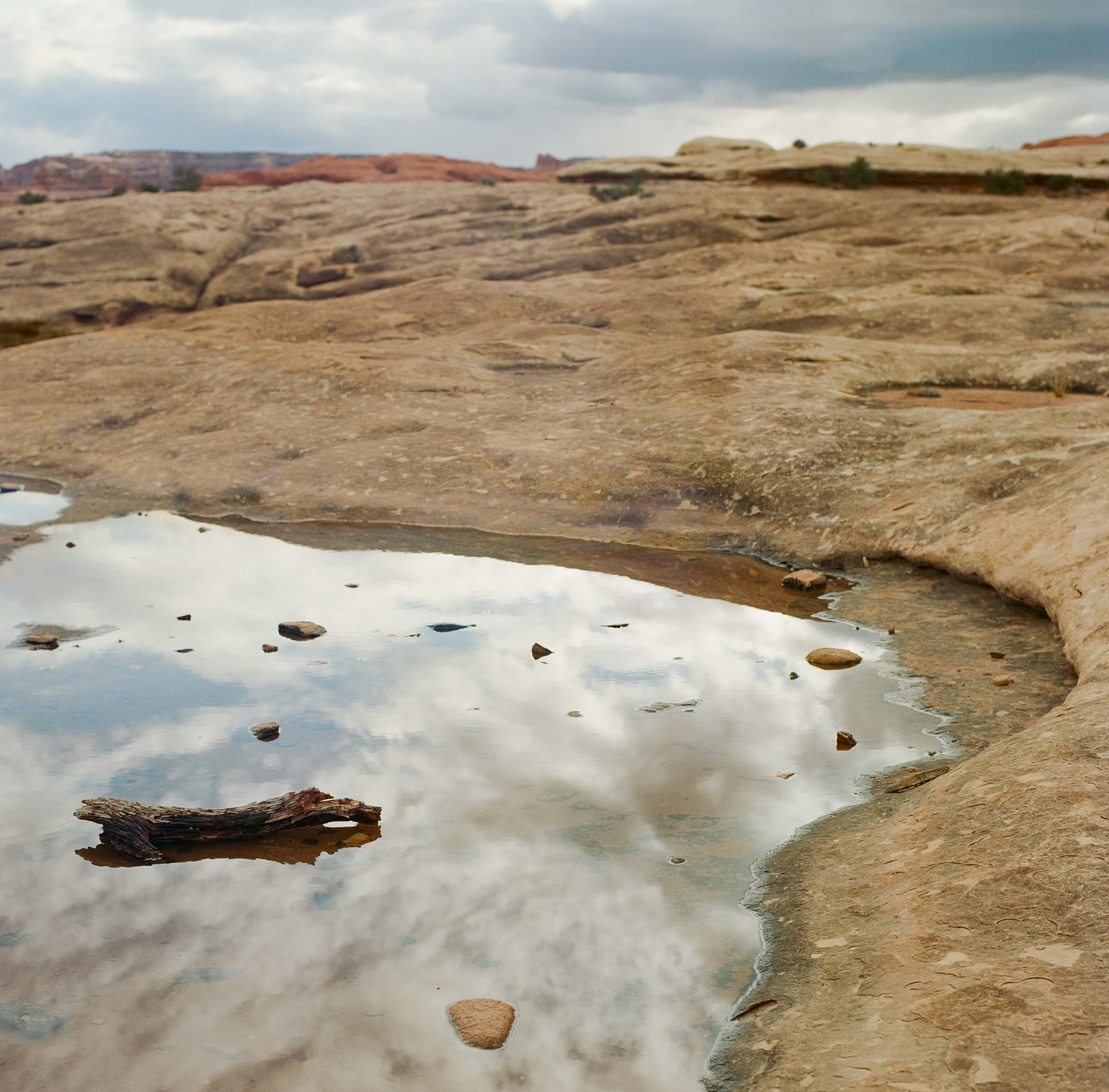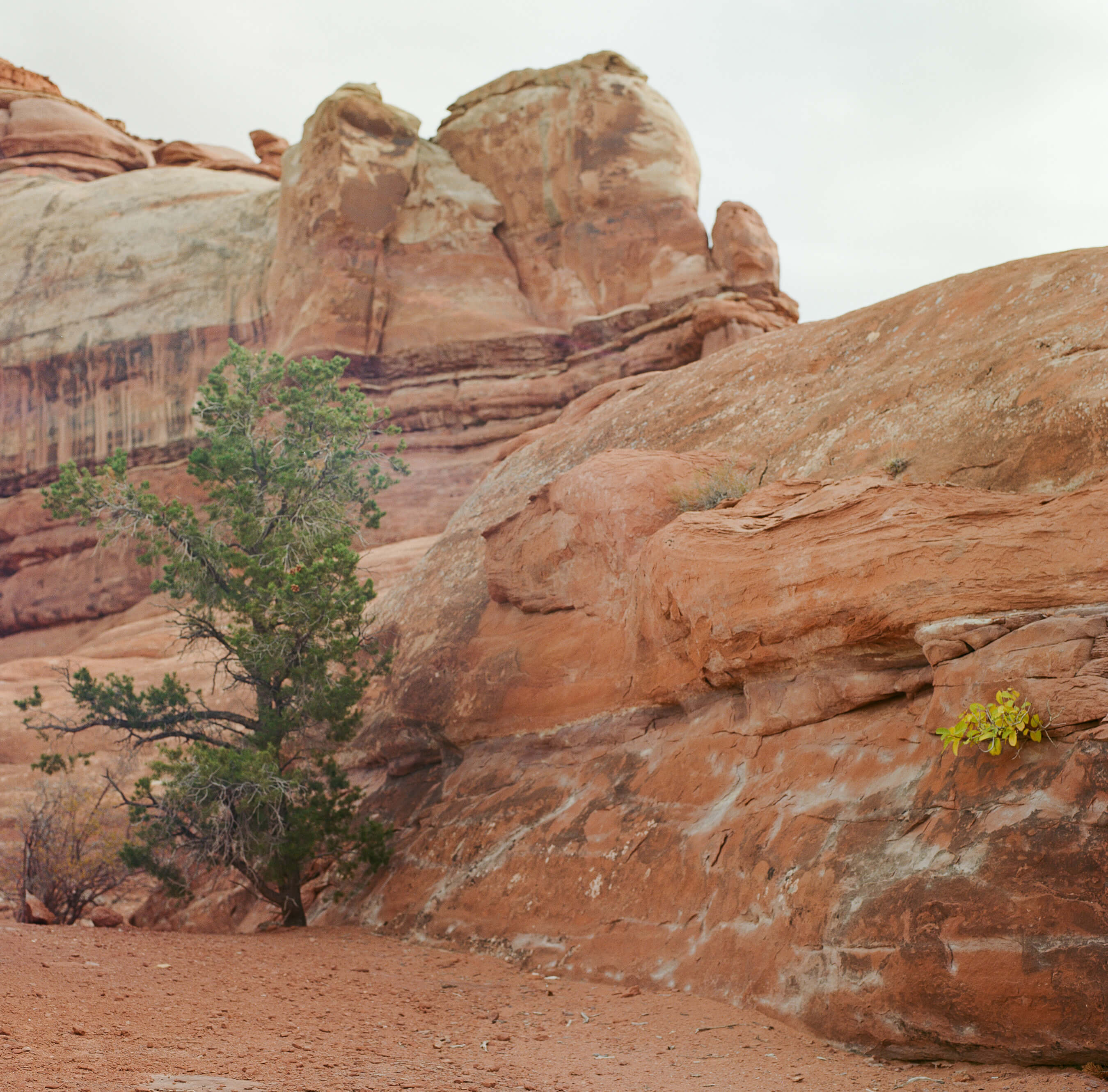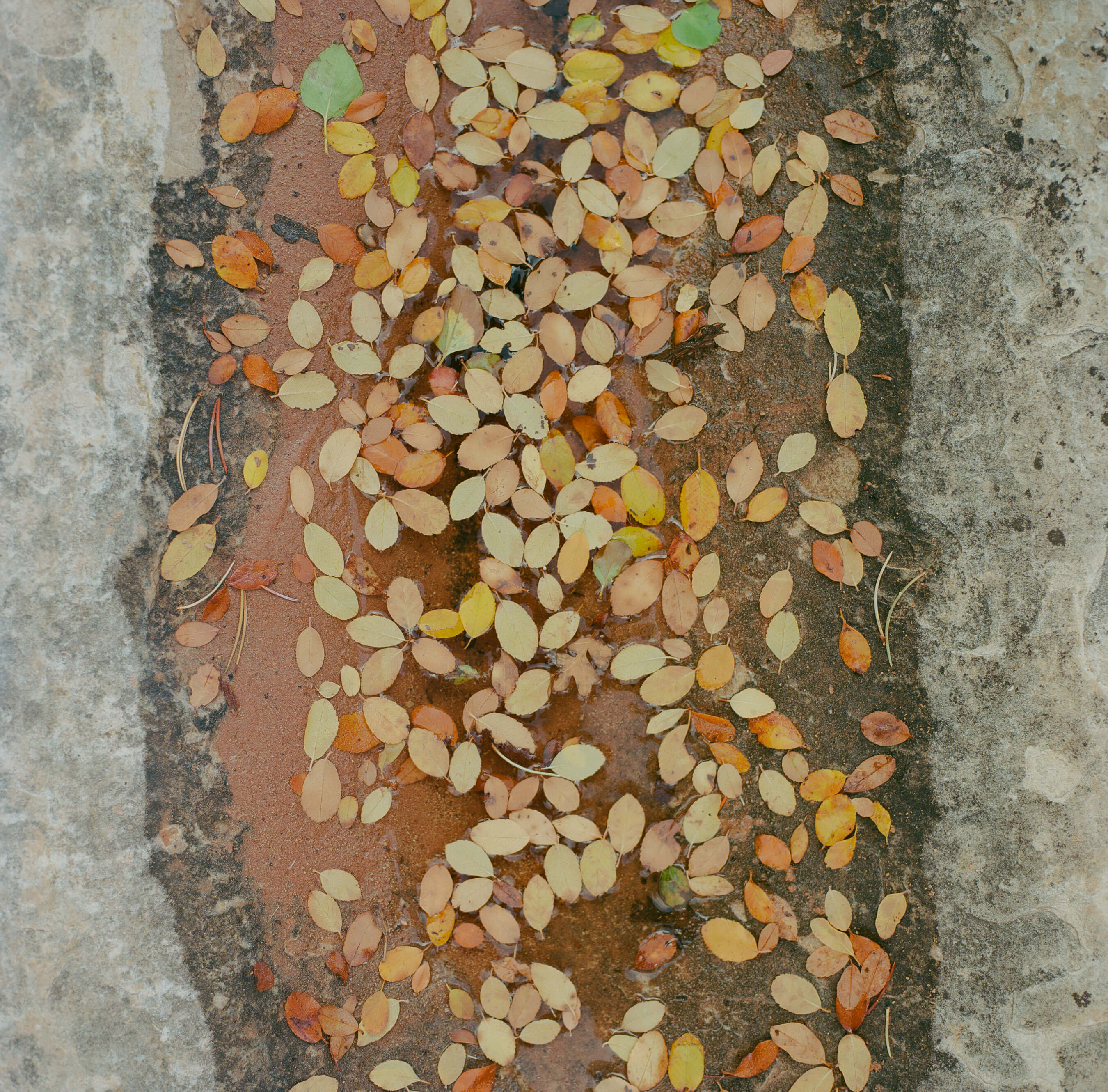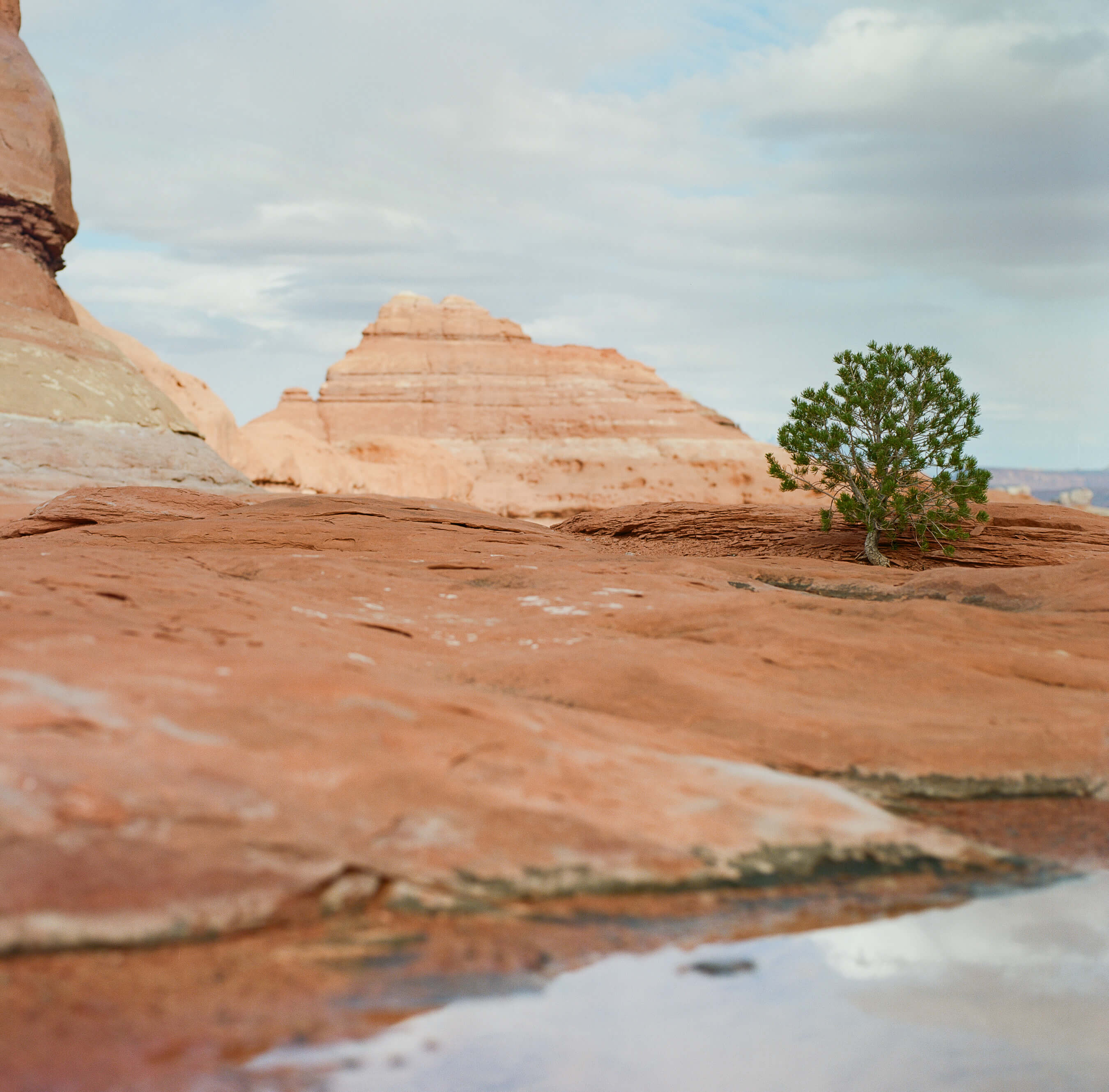Writing for Lost Canyon
This is a companion piece of music, a mix of field recordings from Lost Canyon alongside the Lyra synthesizer and an upright piano, intended to be listened to while reading the essay below.
I wake to my tent etched with a cross stitching of frost, and my half-empty water jug frozen through. It's the kind of cold where every noise breaks sharply across the open ground, with halting finch calls interrupted by tent zippers and gear latches. The sky brightens, its bleached blue expanse lighting upon cliff faces, rock easing from purple to red.
I'm on the trail early, flanked by knee-high cheatgrass glowing neon from the rising sun. My entrance into the canyon lies a couple miles ahead, through loose-packed sand and bands of cedar mesa sandstone. Walking across slick rock, with only dotted cairns leading the way, was an alien experience the first time I ventured out west. I was used to the heavily trafficked east coast woods, with bright tree blazes and dense vegetation to keep you honest. But once you get used to the free flowing terrain of the southwest's deserts, the ability for unbounded exploration becomes addictive.
 The air around me is still, a motionless cold in expectant pause, waiting to see what the day will reveal. Slowly the trail drops, and among the stunted juniper flits a northern mockingbird, with long tail thrust back and a fluffed chest pointing into the sun. It drops down into the sandy edge and back up again, a morning commute of shuffling flight.
The air around me is still, a motionless cold in expectant pause, waiting to see what the day will reveal. Slowly the trail drops, and among the stunted juniper flits a northern mockingbird, with long tail thrust back and a fluffed chest pointing into the sun. It drops down into the sandy edge and back up again, a morning commute of shuffling flight.
From creekbed to drainage wash, the hard ribbed rock gives the impression of frozen waves, crests rounded smooth over generations. Only a mile from the parking lot, it already feels as if the desert has swallowed me whole. Sitting down on a bank of sand, I look across deer track leading towards a murky, silty pool of water. Beside me, an unintelligible track, so lightly pressed into the sand it seems impossible it was attached to a living, breathing, body.
I come here for the quiet. The quiet and space in which it's contained. This is the space of sprawling possibilities, where you can head off in one direction and rarely encounter another set of bootprints. In the desert, there's a natural yearning to head deeper, knowing that beyond a certain point you'll be unable to return to where you first began.
Out here, time is slow. It's a slowness that rises first out of the rocks, like ambient heat from a kiln, settling around you as a heavy blanket. Even light moves slowly, as if unable to grasp the openness of the space, with color stretched across mesa and plain, dusty layers of strewn gold and blue.
But it takes time to settle into this slowness. The inertia of our modern lives, with unending notifications and the constant dopamine hit of distraction lead to a rapidity of existence, like birds in chase, never allowing the orientation towards what makes us whole. You need to touch rock, lay against its unyielding grit, roll the sand through your hands as you stare into the reaches of the sky above. Only then, in direct contact with the physical place in which you exist, does your mind begin to slow.
There's a spirit in the rock, too long of mind to converse with directly, but there, waiting, a long sensing perception nestled within the string of time. They sit through centuries of wind and rain, hard freezes broken quickly by the heat of summer. Lying next to these rocks, you come to understand that our lives are but a brief flash, a temporary moment in search of meaning and fulfillment of desire. To spend time alone, in this wild landscape, is to be pulled outside of yourself, encouraged to reshape your self-assured hold on the world.
 Sit among rock and sun, in silent communion, and they will speak to you, or better yet, through you.
Sit among rock and sun, in silent communion, and they will speak to you, or better yet, through you.
As I sit in the sand, heavy clouds blow in from the west. In canyon country, clouds feel more ominous, with the implication of impending rain, and rain in a canyon is a kind of trouble I'm not interested in being a part of. But there's still a couple miles before any real decision has to be made, with time to watch the weather, and see what changes.
With the sun now obscured, a chill settles quickly into my hands. Back on my feet, I head through a draw of mint-green saltbrush, its flowered tips dried yellow, the palate of the desert on full display. Down into a tangled draw, enveloped by a copse of convoluted juniper and pine, the route ahead momentarily disappears in a compression of perspective, from far horizon to near earth.
The next climb upwards opens to a wide saddle between two outcropping towers. The view breaks open to innumerable canyon walls ahead, with dramatic cuts of dark green below. It's still forty feet to the canyon floor, a sharp detail while edging along a convex wall of rock and narrow ledge. In steep canyons like this, you get a sense of what it must be like for the bighorn sheep, a life of delicately placed footfall in opposition to gravity and stone.
For a moment I watch the sky. The heaviest of clouds have moved south, off-route and without sign of rainfall. The wind is tame, with a southeasterly blow opening patches of light blue sky overhead. It looks as if the worst of it has passed, so I decide to continue on.
The path leads down, down towards a mingle of red oak and ash in sunburst yellow, with juniper shaped like dainty Christmas trees on display. Water must be near.
Following the river, the trail heads west, up and over grass-pocked dunes, into a stand of Fremont cottonwoods. The leaves shake in the wind, rustling eerily similar to rain hitting a metal roof. In spurts, the wind moves down the valley, awakening high trees on the northern slope, then a stand of small, thin trees, with fewer leaves and a looser sound. Finally it reaches the large trees in front of me, crowns full of burnt-orange leaf, building into a crescendo of sound and motion.
 In the solitude of the canyon, the artistry of nature springs apparent. I walk over scalloped riverbed sand, a symmetry of brushed divets, filled only by scattered leaves. One small cottonwood leaf, a curled wheaty yellow, is a dancing a calligraphy of lines and dots at my feet.
In the solitude of the canyon, the artistry of nature springs apparent. I walk over scalloped riverbed sand, a symmetry of brushed divets, filled only by scattered leaves. One small cottonwood leaf, a curled wheaty yellow, is a dancing a calligraphy of lines and dots at my feet.
Still pools of emerald hue stack one after another, increasing in depth like a beaded necklace laid out for display. A mess of green ephedra, more commonly known as Mormon Tea, rises bamboo-like from a low hollow. The cane shoots give way to towering sandstone faces, steeply cut on both sides, narrowing the sky above to a thin ribbon. Deer track, firmly pressed into the sand, weave in and out of the path I follow, storytelling in frozen motion.
Canyons quickly make wanderers of us all.
A canyon is everything the desert is not, thicketed, obscured, winding, with perpetual shadow and flowing water long out of season. It's easy to imagine a canyon as a singular force, one glacial flow of cut rock purposefully carving through the desert landscape. But canyons are resistant to oversimplification. Down here, you're immersed into a world of interlocking fingers and sheltered alcoves, double-kinked river bends, heavily wooded, and crumbling sandy dunes. There's an entire ecosystem on display, a terrarium of aesthetic variety unmatched by the surrounding landscape.
Just off the trail, I find a dinner-table slab of angled sandstone, perfectly inclined to lay against. A branching juniper is close enough overhead to catch its sharp, bitter scent. The canyon walls curve dizzyingly behind me, still, still. Fifteen minutes pass, then thirty.
Slowly my ears begin to calibrate to the silence. There's a low, whistling oscillation, high and far behind, too consistent to be a plane, but wholly unfamiliar to my ears. I imagine I'm hearing the canyon breathing, a steady in and out rhythm of wind tunneling through the uppermost spires. Above, a juniper titmouse, cheeping brightly, a jittery flash of monochromatic gray breaking the settled still.
After a few miles, with a sharp right, the trails climbs up to the canyon's rim. Steeply stacked stones bring me back onto slick rock, into a parabolic slope of austere blankness. The greenness below is gone like a dream. I pick my way across deeply indented stone, like the back of a dinosaur, curving, undulating, with powdery firmness underfoot. Now onto a rise of sand, more juniper and yucca, with the bulk of steep rock behind. A pinyon jay, bully big and tarnished blue, stands at treetop, confused by my recent intrusion. Mountain chickadees, with communal friendliness, dart in front of my steps, with hop and flight, buff gray wings spread against gray sky.
 As the miles fade behind me, I feel profound ease, the realization of yearning met. And yet still, a tinge of longing for the wildness I'm leaving behind.
As the miles fade behind me, I feel profound ease, the realization of yearning met. And yet still, a tinge of longing for the wildness I'm leaving behind.
To be pulled out of your head, following the curiosity of foot and eye, discovering, watching, and exploring. This is what the canyons offer. They are a world of contrasts, hard rock walls jutting out of baby powder sand. Windswept washes neighboring deep, cold pools. All of this, hiding just under the surface, cleft into the earth, an improbable flourishing of life in this patchworked landscape. You too can listen to the canyon's siren song, its faint whisper urging you to venture further into this hallowed land.